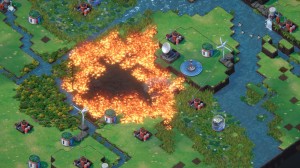Terra Nil

by Nathan Rowland
previewed on PC
Genesis
Popped down into an arid and lifeless landscape, your immediate task is juxtaposed between efforts that are both simple and complex; restore the land and leave no trace of your work behind. A fun twist on the typical city-builder, Terra Nil reverses the process of the well established genre. Instead, it challenges the player to not only create a well organised network of ecocentric buildings and machines, but then, once the terraforming is complete, remove all that was set down to accomplish the task and leave unnoticed.
It is the stark opposite to a game like Wube Software’s Factorio, which challenges you to make the most well-oiled industrial complex, capable of rivalling a modern superpower in its complexity and nuclear capabilities. Terra Nil goes to the humorous length of recommending it to you in it’s completion menu if you prefer “making factories” as opposed to salvaging the world.
Step by Step
With its fairly feature-lite tutorial, the player is up and running, reclaiming the wasteland within minutes, stretching their planetary engineer muscles. At once it is an empowering and relaxing effort to rejuvenate the land. Watching scorched earth transform into lush and verdant fields, towering forests and rolling hills. In this demo, the gameplay loop develops upon a linear path. Step 1, establishing a flourishing landscape with water supplies and greenery. This is organised through buildings which serve a variety of functions like creating power for other buildings or blasting open channels of lands for new riverbeds. Step 2, creating a hospitable ecosystem through the creation of forestry, marshland and pollinated fields. With each biome slowly transforming, the fauna (birds, fish, deer, bees, etc.) slowly start to appear on the land. The final stage comes with the optional goal of regulating the biome's temperature and ambient humidity (for extra points) towards an optimal target. Ultimately however, the player is challenged with the task of dropping down an automated drone to retrieve all of their structures which helped pave the way towards ecological success.
It’s a task which requires a bit of forward planning (as all good conservation should) to ensure that when the time comes, no marks of technological assistance have been left behind. It’s an ingenious little gameplay feature which reinforces the theme of sustainability through your actions in-game, because if you’re not thinking ahead, you’ll end up wasting extra resources or risk not being able to finish the level if you run out. The drone sent out to collect up all your resources can only travel on water channels, so if there isn’t a close enough riverbed to your structures, you’ll be stuck with buildings too far in-land and fail the mission.
Terraforming Us
Beyond this, the demo is rather light on content as of writing, but that only emblematises its brilliance with how deeply it draws you in with seemingly so little. If completely successful, the camera slowly pans away from the ground and reveals a segment of the planet slowly breathed back into life with other neighbouring & barren continents adrift in its oceans. It is both a bleak and triumphant image of a desolate planet slowly being reclaimed. I would like to see this foundation grow into deeper challenges, with larger territories and more varieties of biomes to cultivate whenever Terra Nil releases, but until such a time, I would recommend this demo to anyone if only for its serene and calming soundtrack. This wonderful score by Meydän (acquired by a creative commons licence) sets the tone for the entirety of the gameplay. Despite starting with a completely barren landscape (a ‘wasteland’ as the game describes, inferring an apocalyptic event?) the music focuses the experience into one of optimism and perseverance till the very end.







